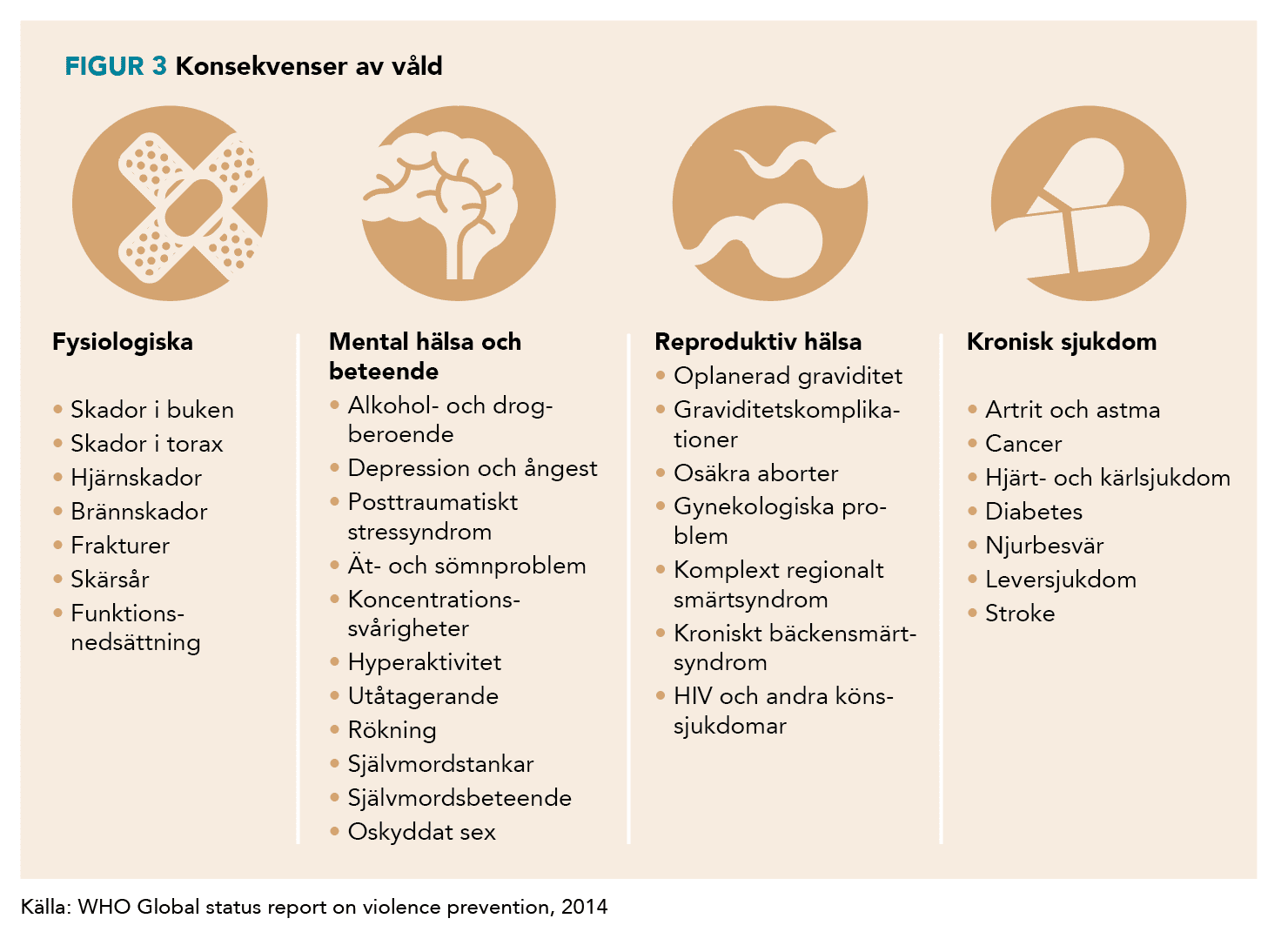1 von Hofer, H. (2011). Brott och straff i Sverige 1750–2010 (Crime and punishment in Sweden 1750–2010), 4:e uppl. Kriminologiska institutionens rapportserie, nr 2011:3. Stockholm: Stockholms universitet.
2 Krug, E. G., Dahlberg, L. L., Mercy, J. A., Zwi, A. B. & Lozano, R. (2002). World report on violence and health. Geneva: World Health Organization.
3 UNODC. (2014). Global Study on Homicide 2013. United Nations publication, Sales No. 14.IV.1
4 WHO. (2014). Global status report on violence prevention, 2014. Geneva: World health organization.
5 WHO. (2013). Global and regional estimates of violence against women: prevalence and health effects of intimate partner violence and non-partner sexual violence. Geneva: World Health Organization.
6 Sethi, D., Bellis, M., Hughes, K., Gilbert, R., Mitis, F., Galea, G. & others. (2013). European report on preventing child maltreatment. Copenhagen: World Health Organization, Regional Office for Europe.
7 Brå. (2017). Nationella trygghetsundersökningen 2016 – Om utsatthet, otrygghet och förtroende. (Swedish Crime Survey 2016). Stockholm: Brottsförebyggande rådet. Rapport 2017:1.
8 WHO. (2016). INSPIRE: Seven strategies for ending violence against children. World Health Organization.
9 WHO. (2006). Elder Abuse and Alcohol. WHO Fact Sheet. Geneva: World Health Organization.
10 Andersson, T., Heimer, G. & Lucas, S. (2015). VIOLENCE AND HEALTH IN SWEDEN: A National Prevalence Study on Exposureto Violence among Women and Men and its Association to Health. Uppsala: National Centre for Knowledge on Men’s Violence Against Women.
11 Berglund, A. & Heimer, G. (2016). Att ha varit utsatt för våld ökar risken för ohälsa senare i livet. Läkartidningen, 113.
12 WHO. (2009). Preventing violence by reducing the availability and harmful use of alcohol. Geneva: World Health Organization.
13 Bye, E.K., Rossow, I. (2010). The impact of drinking pattern on alcohol-related violence among adolescents: An international comparative analysis. Drug Alcohol Rev. 2010 Mar;29(2):131–7.
14 Powell, L.M., Czart Ciecierski, C.U., Chaloupka, F.J., Wechsler, H. (2002). Binge Drinking and Violence among College Students: Sensitivity to Correlation in the Unobservables. ImpacTeen: Research Paper Series, No. 20. University of Illinois at Chicago.
15 Kuhns, J. B., Wilson, D. B., Clodfelter, T. A., Maguire, E. R. & Ainsworth, S. A. (2011). A meta-analysis of alcohol toxicology study findings among homicide victims. Addiction (Abingdon, England), 106(1), 62–72.
16 WHO. (2006). Interpersonal Violence and Alcohol. WHO Policy Briefing. Geneva: World Health Organization.
17 Boles, S. M. & Miotto, K. (2003). Substance abuse and violence: A review of the literature. Aggression and Violent Behavior, 8(2), 155–174.
18 WHO. (2006). Intimate Partner Violence and Alcohol. WHO Fact Sheet. Geneva: World Health Organisation.
19 Larsen, M.L., Hilden, M., Lidegaard, Ø. (2015). Sexual assault: a descriptive study of 2500 female victims over a 10-year period. BJOG. 2015 Mar;122(4):577–84.
20 Brå. (2017). Brottsutvecklingen i Sverige fram till år 2015. (Crime trends in Sweden up to 2015.) Rapport 2017:5. Stockholm: Brå
21 Brå. (2011). Polisanmälda våldtäkter mot barn. En uppdaterad kunskapsbild. (Child rapes reported to the police) Rapport 2011:6. Stockholm, Brå.
22 Brå (2009). Våld mot kvinnor och män i nära relationer. Våldets karaktär och offrens erfarenheter av kontakter med rättsväsendet. (Partner violence against women and men.) Rapport 2009:12.
23 Brå. (2005). Våldtäkt. En kartläggning av polisanmälda våldtäkter. (National study of rapes reported to the police.) Rapport 2005:7.
24 Brå. (2015). Kortanalys – Alkohol- och drogpåverkan vid misshandel, hot, personrån och sexualbrott. (Alcohol and drugs in connection with assault, threats, robberies and sexual crime.)
25 Exum, M.L. (2006). Alcohol and aggression: an integration of findings from experimental studies. Journal of Criminal Justice, vol. 34, no. 2, pp. 131–145.
26 Attwood, A.S. & Munafò, M.R. (2014). Effects of acute alcohol consumption and processing of emotion in faces: Implications for understanding alcohol-related aggression. Journal of Psychopharmacology (Oxford, England), 28(8), 719–32.
27 George, W.H., Stoner, S.A. (2014). Understanding acute alcohol effects on sexual behavior. Annual Review of Sex Research. 2000;11:92–124, in Abbey et.al. 2014 (ref 28).
28 Abbey, A., Wegner, R., Woerner, J., Pegram, S.E., & Pierce, J. (2014). Review of Survey and Experimental Research That Examines the Relationship Between Alcohol Consumption and Men’s Sexual Aggression Perpetration. Trauma, Violence & Abuse, 15(4), 265–282.
29 Crane, C.A., Godleski, S.A., Przybyla, S.M., Schlauch, R. C. & Testa, M. (2016). The Proximal Effects of Acute Alcohol Consumption on Male-to-Female Aggression. Trauma, Violence, \& Abuse, 17(5), 520–531.
30 Gidycz, C.A., McNamara, J.R. & Edwards, K.M. (2006). Women’s risk perception and sexual victimization: A review of the literature. Aggression and Violent Behavior, 11(5), 441–456.
31 Bushman, B.J. (1997). Effects of alcohol on human aggression. Validity of proposed explanations. In: Galanter, M., ed. Alcohol and Violence: Epidemiology, Neurobiology, Psychology, Family Issues. Recent Developments in Alcoholism, Vol. 13. New York: Plenum Press, 1997. pp. 227–243. In Exum 2006 (ref 25).
32 Norström, T. (2001). Per capita alcohol consumption and all-cause mortality in 14 European countries. Addiction. 2001;96(1s1):113–28.
33 Andréasson, S., Holder, H.D., Norström, T., Osterberg, E. & Rossow, I. (2006). Estimates of harm associated with changes in Swedish alcohol policy: results from past and present estimates. Addiction (Abingdon, England), 101(8), 1096–105.
34 Stockwell, T., Norström, T., Angus, C., Sherk, A., Ramstedt, M., Andréasson, S., Chikritzhs, T., Gripenberg, J., Holder, H., Holmes, J. & Mäkelä, P. (2017). What are the public health and safety bene¬fits of the Swedish government alcohol monopoly? Victoria, BC: Centre for Addictions Research of BC, University of Victoria, Victoria, BC, Canada.
35 Bye, E.K. (2007). Alcohol and violence: use of possible confounders in a time-series analysis. Addiction (Abingdon, England), 102(3), 369–76.
36 Liang, W., Chikritzhs, T. (2015). Examining the Relationship between Heavy Alcohol Use and Assaults: With Adjustment for the Effects of Unmeasured Confounders. Biomed Res Int.;2015:596179.
37 Pihl, R. O. & Sutton, R. (2009). Drugs and Aggression Readily Mix; So What Now? Substance Use \& Misuse, 44(9-10), 1188–1203.
38 Foran, H.M. & O’Leary, K.D. (2008). Alcohol and intimate partner violence: a meta-analytic review. Clinical Psychology Review, 28(7), 1222–34.
39 Haggård-Grann, U., Hallqvist, J., Långström, N. & Möller, J. (2006). The role of alcohol and drugs in triggering criminal violence: a case-crossover study. Addiction (Abingdon, England), 101(1), 100–8.
40 Caetano, R.; Cunradi, C.B.; Clark, C.l.; and Schafer, J. (2000). Intimate partner violence and drinking patterns among White, Black, and Hispanic couples in the U.S. Journal of Substance Abuse 11(2):123–138, 2000.
41 Thompson, M.P., and Kingree, J.B. (2006). The roles of victim and perpetrator alcohol use in intimate partner violence outcomes. Journal of Interpersonal Violence 21(2):163–177, 2006.
42 LaFlair, L.N.; Bradshaw, C.P., Storr, C.l. et.al. (2012). Intimate partner violence and patterns of alcohol abuse and dependence criteria among women: a latent class analysis. Journal of Studies on Alcohol and Drugs 73(3):351–360, 2012.
43 Rothman, E.F., McNaughton Reyes, l., Johnson, R.M., and LaValley, M. (2012). Does the alcohol make them do it? Dating violence perpetration and drinking among youth. Epidemiologic Reviews 34(1):103–119, 2012.
44 Graham, K.; Bernards, S.; Munné, M.; and Wilsnack, S.C. (2008). Unhappy Hours: Alcohol and Partner Aggression in the Americas. Washington, DC: Pan American Health Organization.
45 Abramsky, T.; Watts, C.H.; Garcia-Moreno, C. et al. (2011). What factors are associated with recent intimate partner violence? Findings from the WHO multi-country study on women’s health and domestic violence. BMC Public Health 11:109, 2011.
46 Graham, K.; Bernards, S.; Wilsnack, S.C and Gmel, G. (2011). Alcohol may not cause partner violence but it seems to make it worse: a cross national comparison of the relationship between alcohol and severity of partner violence. Journal of Interpersonal Violence 26(8):1503–1523, 2011.
47 Boden, J.M., Fergusson, D.M., & Horwood, L.J. (2012). Alcohol misuse and violent behavior: Findings from a 30-year longitudinal study. Drug and Alcohol Dependence, 122, 135–141.
48 Leonard, K.E., Bromet, E.J., Parkinson, D.K., Day, N.L., & Ryan, C.M. (1985). Patterns of alcohol use and physically aggressive behavior in men. Journal of Studies on Alcohol, 46(4), 279–282.
49 Pan H, Neidig P, O’Leary K (1994). Predicting mild and severe husband-to-wife physical aggression. J Consult Clin Psychol 62:975–981.
50 Leonard, K.E. & Senchak, M. (1993). Alcohol and premarital aggression among newlywed couples. Journal of Studies on Alcohol, 11, 96–108.
51 Reider, E.E., Zucker, R.A., Noll, R.B., Maguin, E.T. & Fitzgerald, H.E. (1988). Alcohol Involvement and Family Violence in a High Risk Sample. Paper presented at the Annual Meeting of the American Psychological Association, Atlanta, GA .
52 Kaufman Kantor, G. & Straus, M.A. (1990). The ‘drunken bum’ theory of wife beating. In: Straus, M. A. & Gelles, R.J., eds. Physical Violence in American Families: Risk factors and Adaptations to Violence in 8,145 families, pp. 203–224. New Brunswick, NJ: Transaction Publishers.
53 Pan, H. , Neidig, P.H. & O’Leary, K.D. (1994). Predicting mild and severe husband to wife aggression. Journal of Consulting and Clinical Psychology, 62, 975–981.
54 McHenry, P.C., Julian, T.W. & Gavazzi, S.M. (1995). Toward a biopsychosocial model of domestic violence. Journal of Marriage and the Family, 57, 309–319.
55 Leonard, K.E. (2001) Domestic violence and alcohol. What is known and what do we need to know to encourage environmental interventions? Journal of Substance Use, 6, 235–247.
56 Leonard, K.E. (2005). Alcohol and intimate partner violence: when can we say that heavy drinking is a contributing cause of violence? Addiction, 100, 422–425.
57 Leonard, K.E. & Senchak, M. (1996). The prospective prediction of husband marital aggression among newlywed couples. Journal of Abnormal Psychology, 105, 369–380.
58 Leonard, K.E. & Quigley, B.M. (1999). Drinking and marital aggression in newlyweds: an event-based analysis of drinking and the occurrence of husband marital aggression. Journal of Studies on Alcohol, 60, 537–545.
59 Reay, A.C., & Browne, K.D. (2001). Risk factor characteristics in carers who physically abuse or neglect their elderly dependants. Aging & mental health, 5(1), 56–62.
60 Choenni, V., Hammink, A. & van de Mheen, D. (2017). Association Between Substance Use and the Perpetration of Family Violence in Industrialized Countries: A Systematic Review. Trauma, Violence & Abuse, 18(1), 37–50.
61 Fogarty, J. (2006). The nature of the demand for alcohol: understanding elasticity. Br Food J 108:316–32.
62 Gallet, C.A. (2007). The demand for alcohol: a meta-analysis of elasticities. Aust J Agric Resour Econ 51:121–35.
63 Wagenaar, A.C., Tobler, A.L., Komro, K.A. (2010). Effects of alcohol tax and price policies on morbidity and mortality: a systematic review. Am J Public Health 100:2270–8.
64 Chikritzhs, T., Stockwell, T. (2002). The impact of later trading hours for Australian public houses (hotels) on levels of violence. J Stud Alcohol 63:591–9.
65 Stockwell, T., Chikritzhs, T. (2009). Do relaxed trading hours for bars and clubs mean more relaxed drinking? A review of international research on the impacts of changes to permitted hours of drinking. Crime Prev Community Saf 11:153–70.
66 Popova, S., Giesbrecht, N., Bekmuradov, D., Patra, J. (2009). Hours and days of sale and density of alcohol outlets: impacts on alcohol consumption and damage: a systematic review. Alcohol Alcohol 44:500–16.
67 Stockwell, T., Zhao, J., Macdonald, S., Pakula, B., Gruenewald, P., Holder, H. (2009). Changes in per capita alcohol sales during the partial privatization of British Columbia’s retail alcohol monopoly 2003–2008: a multi-level local area analysis. Addiction 104:1827–36.
68 Campbell, C.A., Hahn, R.A., Elder, R., Brewer, R., Chattopadhyay, S., Fielding, J. et al. (2009). The effectiveness of limiting alcohol outlet density as a means of reducing excessive alcohol consumption and alcohol-related harms. Am J Prev Med 37:556–69.
69 Fitterer, J.L., Nelson, T. A. & Stockwell, T. (2015). A Review of Existing Studies Reporting the Negative Effects of Alcohol Access and Positive Effects of Alcohol Control Policies on Interpersonal Violence. Frontiers in Public Health, 3, 253.
70 Kypri, K. (2015). Evidence of harm from late night alcohol sales continues to strengthen. Addiction, 110, 965–966.
71 Menéndez, P., Kypri, K., and Weatherburn, D. (2017). The effect of liquor licensing restrictions on assault: a quasi-experimental study in Sydney, Australia. Addiction, 112: 261–268.
72 Stockwell, T., Zhao, J., Marzell, M., Gruenewald, P., Macdonald, S., Ponicki, W. & Martin, G. (2015). Relationships between minimum alcohol pricing and crime during the partial privatization of a Canadian government alcohol monopoly. Journal of Studies on Alcohol and Drugs, 76(4), 628–634.
73 Stockwell, T., Zhao, J., Sherk, A., Callaghan, R. C., Macdonald, S., and Gatley, J. (2017). Assessing the impacts of Saskatchewan’s minimum alcohol pricing regulations on alcohol-related crime. Drug and Alcohol Review, 36: 492–501.
74 MacAndrew, C. & Edgerton, R. eds. (1969). Drunken Comportment: a social explanation. Chicago: Aldine.
75 Graham, K., & Homel, R. (2008). Raising the bar: preventing aggression in and around bars, pubs and clubs. Cullompton: Willan
76 Monuteaux, M.C., Lee, L.K., Hemenway, D., Mannix, R., & Fleegler, E.W. (2015). Firearm ownership and violent crime in the US: an ecologic study. American journal of preventive medicine, 49(2), 207–214.
77 Macintyre, S., Homel, R. (1997). Danger on the dance floor: a study of interior design, crowding and aggression in nightclubs, in Policing for Prevention: Reducing Crime, Public Intoxication and Injury (Homel R ed.), pp 91–113.Criminal Justice Press, Monsey, New York.
78 Nemtsov, A.V. (1998). Alcohol-related harm and alcohol consumption in Moscow before, during and after a major anti-alcohol campaign. Addiction 93:1501−1510.
79 Interpersonal violence and alcohol in the Russian Federation. Copenhagen, WHO Regional Office for Europe, 2006 (http://www.euro.who.int/__data/ assets/pdf_file/0011/98804/E88757.pdf.
80 Balan-Cohen A. (2008). Sobering up: the impact of the 1985−1988 Russian anti-alcohol campaign on child health. Boston, MA, Tufts University.
81 Naimi, T.S., Xuan, Z., Coleman, S.M., Lira, M., Hadland, S.E., Cooper, S.E., Heeren, T.C. & Swahn, M.H. (2017). Alcohol Policies and Alcohol-Involved Homicide Victimization in the United States. J. Stud. Alcohol Drugs, 78. (In press).
82 Wagenaar, A.C., Salois, M. J., & Komro, K.A. (2009). Effects of beverage alcohol price and tax levels on drinking: A meta-analysis of 1003 estimates from 112 studies. Addiction, 104, 179–190.
83 Elder, R., Lawrence, B., Ferguson, A., Naimi, T.S., Brewer, R., Chattopadhyay, S.K., … Fielding, J.E. (2010). The effectiveness of tax policy interventions for reducing excessive alcohol consumption and related harms. American Journal of Preventive Medicine, 38, 217–229.
84 Babor, T. ed. (2010). Alcohol: no ordinary commodity: research and public policy. Oxford University Press.
85 Fone, D., Morgan, J., Fry, R. et al. (2016). Change in alcohol outlet density and alcohol-related harm to population health (CHALICE): a comprehensive record-linked database study in Wales. Southampton (UK): NIHR Journals Library; 2016 Mar. (Public Health Research, No. 4.3.) Chapter 1, Alcohol outlet density and harm to population health: literature review.
86 Gmel, G., Holmes, J., Studer, J. (2015). Are alcohol outlet densities strongly associated with alcohol-related outcomes? A critical review of recent evidence. Drug Alcohol Rev. 2015 Jun 29.
87 Tabb, L.P., Ballester, L., Grubesic, T.H. (2016). The spatio-temporal relationship between alcohol outlets and violence before and after privatization: A natural experiment, Seattle, Wa 2010–2013. Spat Spatiotemporal Epidemiol. 2016 Nov;19:115–124.
88 Norström, T. (2000). Outlet density and criminal violence in Norway, 1960–1995. J Stud Alcohol. 2000 Nov;61(6):907–11.
89 Makela, P., Tryggvesson, K., Rossow, I. (2002). Who drinks more or less when policies change? The evidence from 50 years of Nordic studies. In: Room, R., ed. The effects of Nordic alcohol policies: What happens to drinking and harm when control systems change? (Publication 42). Helsinki: Nordic Council for Alcohol and Drug Research, 2002.
90 Livingston, M. (2011). A longitudinal analysis of alcohol outlet density and domestic violence, Addiction, 106, 919–925
91 Hahn, R.A., Kuzara, J.L., Elder, R., Brewer, R., Chattopadhyay, S., Fielding, J., Naimi, T.S., Toomey, T., Middleton, J.C., Lawrence, B., Task Force on Community Preventive Services. (2010). Effectiveness of policies restricting hours of alcohol sales in preventing excessive alcohol consumption and related harms. Am J Prev Med 2010;39(6):590–604.
92 Middleton, J.C., Hahn, R.A., Kuzara, J.L., Elder, R., Brewer, R., Chattopadhyay, S., Fielding, J., Naimi, T.S., Toomey, T., Lawrence, B., Task Force on Community Preventive Services. (2010). Effectiveness of policies maintaining or restricting days of alcohol sales on excessive alcohol consumption and related harms. Am J Prev Med 2010;39(6):575–89.
93 Wilkinson, C., Livingston, M. & Room, R. (2016). Impacts of changes to trading hours of liquor licences on alcohol-related harm: a systematic review 2005–2015. Public Health Research & Practice, 26(4).
94 Kypri, K., Jones, C., McElduff, P., & Barker, D. (2011). Effects of restricting pub closing times on night-time assaults in an Australian city. Addiction (Abingdon, England), 106(2), 303–310.
95 Kypri, K., McElduff, P. and Miller, P. (2014), Restrictions in pub closing times and lockouts in Newcastle, Australia five years on. Drug Alcohol Rev, 33: 323–326.
96 Kypri, K., McElduff, P., and Miller, P. (2016) Night-time assaults in Newcastle 6–7 years after trading hour restrictions. Drug Alcohol Rev, 35: E1–E2.
97 Rossow, I., & Norström, T. (2012). The impact of small changes in bar closing hours on violence. The Norwegian experience from 18 cities. Addiction (Abingdon, England), 107(3), 530–537.
98 Bormann, C.A., Stone, M.H. (2001). The effects of eliminating alcohol in a college stadium: The Folsom Field beer ban. The Journal of American College Health, 2001,50:8]–88.
99 Wilson, I.M., Graham, K. & Taft, A. (2014). Alcohol interventions, alcohol policy and intimate partner violence: A systematic review. BMC Public Health, 14, 881.
100 Willner, P. et al. (2000). Alcohol sales to underage adolescents: an unobtrusive observational field study and evaluation of a police intervention. Addiction 95:1373–1388.
101 Wagenaar, A. C., & Toomey, T. L. (2002). Effects of minimum drinking age laws: Review and analyses of the literature from 1960 to 2000. Journal of Studies on Alcohol, Supplement 14, 206–225.
102 DeJong, W., & Blanchette, J. (2014). Case closed: research evidence on the positive public health impact of the age 21 minimum legal drinking age in the United States. Journal of Studies on Alcohol and Drugs, Supplement, (s17), 108–115.
103 Plunk, A.D., Cavazaos-Rehg, P., Bierut, L.J., & Grucza, R.A. (2013). The persistent effects of minimum legal drinking age laws on drinking patterns later in life. Alcoholism: Clinical and Experimental Research, 37, 463–469.
104 Norberg, K. E., Bierut, L. J., & Grucza, R. A. (2009). Long-term effects of minimum drinking age laws on past-year alcohol and drug use disorders. Alcoholism: Clinical and Experimental Research, 33, 2180–2190.
105 Callaghan, R.C., Gatley, J.M., Sanches, M., Benny, C. (2016). Do drinking-age laws have an impact on crime? Evidence from Canada, 2009–2013. Drug Alcohol Depend. 2016 Oct 1;167:67–74.
106 Kypri, K., Davie, G., McElduff, P., Connor, J., Langley, J. (2014). Effects of lowering the minimum alcohol purchasing age on weekend assaults resulting in hospitalization in New Zealand. Am J Public Health. 2014 Aug;104(8):1396–401.
107 Grucza, R.A., Hipp, P.R., Norberg, K.E., Rundell, L., Evanoff, A., Cavazos-Rehg, P., & Bierut, L. J. (2012). The legacy of minimum legal drinking age law changes: Long-term effects on suicide and homicide deaths among women. Alcoholism, Clinical and Experimental Research, 36(2), 377–384.
108 Graham, K., Schmidt, G., Gillis, K. (1996). Circumstances when drinking leads to aggression: an overview of research findings. Contemporary Drug Problems, 1996, 23:493–557.
109 Brennan, I., Moore, S. C., Byrne, E., & Murphy, S. (2011). Interventions for disorder and severe intoxication in and around licensed premises, 1989–2009. Addiction, 106, 706–713.
110 Jones, L., Hughes, K., Atkinson, A.M., & Bellis, M.A. (2011). Reducing harm in drinking environments: A systematic review of effective approaches. Health & Place, 17(2), 508–518.
111 Wallin, E., Norström, T., Andréasson, S. (2003). Alcohol prevention targeting licensed premises: a study of effects on violence. Journal of Studies on Alcohol;64:270–77.
112 Månsdotter, A.M., Rydberg, M.K., Wallin, E., Lindholm, L.A., Andréasson, S. (2007). A cost-effectiveness analysis of alcohol prevention targeting licensed premises. Eur J Public Health. 2007 Dec;17(6):618–23.
113 Trolldal, B., Brännström, L., Paschall, M. J. & Leifman, H. (2013). Effects of a multi-component responsible beverage service programme on violent assaults in Sweden. Addiction (Abingdon, England), 108(1), 89–96.
114 Warpenius, K., Holmila, M., Mustonen, H. (2010). Effects of a community intervention to reduce the serving of alcohol to intoxicated patrons. Addiction;105:1032–40.
115 Skardhamar, T., Fekjær, S.B., Pedersen, W. (2016). If it works there, will it work here? The effect of a multi-component responsible beverage service (RBS) programme on violence in Oslo. Drug Alcohol Depend. 2016 Dec 1;169:128–133.
116 McKnight, A.J., Streff, F.M. (1994). The effect of enforcement upon service of alcohol to intoxicated patrons of bars and restaurants. Accident Analysis & Prevention, 1994, 26.1: 79–88.
117 Ramstedt, M., Leifman, H., Müller, D., Sundin, E., Norström, T. (2013). Reducing youth violence related to student parties: Findings from a community intervention project in Stockholm. Drug Alcohol Rev. 2013 Nov;32(6):561–5.
118 Stafström M, Ostergren PO. (2008). A community-based intervention to reduce alcohol-related accidents and violence in 9th grade students in southern Sweden: the example of the Trelleborg project. Accid Anal Prev. 2008 May;40(3):920-5.
119 BRÅ. (2009). Utvärdering av Kronobergsmodellen: En polisiär arbetsmetod för att förebygga våld i offentlig miljö. (Evaluation of the Kronoberg model.) Rapport 2009:5. Stockholm: Brottsförebyggande rådet (Swedish National Council for Crime Prevention).
120 Homel, R., Carvolth, R., Hauritz, M., McIlwain, G. and Teague, R. (2004). Making licensed venues safer for patrons: what environmental factors should be the focus of interventions? Drug and Alcohol Review, 23: 19–29.
121 Holder, H.D., Gruenewald, P.J., Ponicki, W.R., Treno, A.J., Grube, J.W., Saltz, R.F., Voas, R.B., Reynolds. R., Davis, J., Sanchez, L., Gaumont, G., Roeper, P. (2000). Effect of community-based interventions on high-risk drinking and alcohol-related injuries. JAMA. 2000 Nov 8;284(18):2341–7.
122 Hahn, R.A., Middleton, J.C., Elder, R., Brewer, R., Fielding, J., Naimi, T.S., Toomey, T.L., Chattopadhyay. S., Lawrence, B., Campbell, C.A., Community Preventive Services Task Force. (2012). Effects of alcohol retail privatization on excessive alcohol consumption and related harms: a Community Guide systematic review. Am J Prev Med 2012;42(4):418–27.
123 Norström, T., Miller, T., Holder, H., Österberg, E., Ramstedt, M., Rossow, I. and Stockwell, T. (2010), Potential consequences of replacing a retail alcohol monopoly with a private licence system: results from Sweden. Addiction, 105: 2113–2119.
124 Lippy, C. & DeGue, S. (2016). Exploring Alcohol Policy Approaches to Prevent Sexual Violence Perpetration. Trauma, Violence & Abuse, 17(1), 26–42.
125 Room, R. et al. (2003). Alcohol in developing societies: a public health approach. Helsinki and Geneva, Finnish Foundation for Alcohol Studies and World Health Organization, 2003.
126 FARE. (2015). Preventing alcohol-related family and domestic violence. Deakin: Foundation for Alcohol research & Education.
127 Stuart, G.L. et al. (2003). Reductions in marital violence following treatment for alcohol dependence. Journal of lnterpersonal Violence, 2003. 18:1113–1131.
128 Ward, C. L., Mertens, J. R., Bresick, G. F., Little, F., & Weisner, C. M. (2015). Screening and Brief Intervention for Substance Misuse: Does It Reduce Aggression and HIV-Related Risk Behaviours? Alcohol and Alcoholism (Oxford, Oxfordshire), 50(3), 302–309.
129 Andrews, A.B., McLeese, D.G., Curran, S. (1995). The impact of a media campaign on public action to help maltreated children in addictive families. Child Abuse and Neglect, 1995, 19:921–932.
130 WHO. (2006). Child Maltreatment and Alcohol. WHO Fact Sheet. Geneva: World Health Organization.
131 Chang, G. et al. (2005). Brief intervention for prenatal alcohol use: a randomised trial. Obstetrics and Gynaecology, 105:991–998.
132 McLean et al. (1997). Risks associated with occupational glass injury in bar staff with special consideration of hepatitis B infection. Occup. Mod. Vol. 47, No. 3, pp. 147–150.
133 Blow, F.C., Walton, M.A., Murray, R., Cunningham, R.M., Chermack, S.T., Barry, K.L. et al. (2010). Intervention attendance among emergency department patients with alcohol- and drug-use disorders. Journal of Studies on Alcohol and Drugs. 2010;71(5):713.
134 WHO. (2015). Preventing youth violence: an overview of the evidence. Geneva: World Health Organization.













